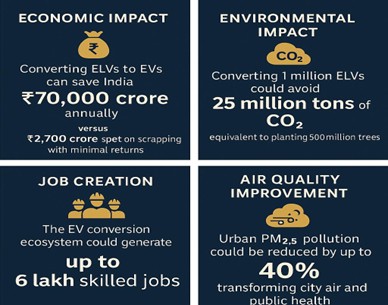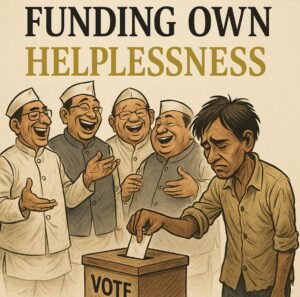Junk to Juice: How Can India’s 10 million Dead Cars Power a ₹70,000 Crore Revolution
What if India’s automotive graveyard held the secret to energy independence? While 10 million dying vehicles choke our roads and drain our wallets, a revolutionary solution emerges: convert these metal corpses into electric powerhouses. The economics are staggering, the environmental impact transformative, and the timing absolutely critical

From Death Traps to Green Machines: The ₹70,000 Crore Opportunity Sitting in India’s Junkyards
New Delhi’s smog-choked streets tell a familiar story of urban decay and environmental crisis. But hidden within this narrative of despair lies an extraordinary opportunity that could rewrite India’s economic and environmental future in a single stroke.
The revelation is as simple as it is revolutionary: instead of scrapping India’s 10 million end-of-life vehicles at enormous cost and minimal benefit, the nation could transform them into electric vehicles, unlocking annual savings of ₹70,000 crore while creating a cleaner, more prosperous tomorrow.
This isn’t wishful thinking, it’s mathematical certainty backed by compelling data from leading research institutions and early pilot successes across Indian cities.
Environmental Impact
- CO₂ Prevention: 20-30 million tons from 1 million conversions
- Tree Equivalent: 500 million mature trees planted instantly
- Air Quality Gain: 40% reduction in urban PM2.5 pollution
- Lives Saved: Addressing 1.67 million annual pollution deaths
The Scrappage Scandal: Why India’s Current Plan is Economic Suicide
India’s current vehicle scrappage policy reads like a masterclass in resource wastage. The government proposes spending ₹2,700 crore to dismantle 10 million vehicles, achieving virtually nothing beyond clearing space in already overcrowded junkyards.
The arithmetic is brutal: ₹12,000 to ₹27,000 per vehicle for destruction, with minimal environmental gains and zero economic returns. It’s the equivalent of burning money to light a candle when you could build a power plant instead.
Meanwhile, the conversion alternative presents numbers that defy conventional wisdom. Each vehicle transformation costs ₹3.2 to ₹8.6 lakh today, expensive initially, but delivering ₹5 to ₹12 lakh in fuel savings over a decade. The mathematics become even more compelling when battery prices plummet by 40% before 2030, reducing conversion costs to ₹2-6 lakh per vehicle.

The Triple Win: Economy, Environment, and Energy Security
Economic Transformation
The financial case for conversion demolishes every alternative. With 10 million vehicles saving ₹70,000 crore annually in oil imports, India could redirect this astronomical sum toward infrastructure, education, and healthcare. Each converted vehicle generates ₹2-5 lakh profit within five years, creating a self-sustaining economic ecosystem.
Environmental Revolution
One million conversions prevent 20-30 million tons of CO₂ emissions—equivalent to planting 500 million mature trees overnight. For a nation where 1.67 million people die prematurely from air pollution annually, converting commercial fleets could slash urban PM2.5 levels by 40%, literally saving hundreds of thousands of lives.
Energy Independence
India hemorrhages ₹2.3 lakh crore annually on oil imports, funding geopolitical adversaries while depleting national wealth. EV conversion could reduce this dependency by 30%, insulating the economy from volatile global energy markets and strengthening national security.
THE CONVERSION CALCULATOR: NUMBERS THAT DEMAND ACTION
Financial Revolution
- Annual Oil Savings: ₹70,000 crore (vs ₹2,700 crore scrapping waste)
- Per Vehicle Returns: ₹5-12 lakh savings over 10 years
- Conversion Investment: ₹3.2-8.6 lakh today, falling to ₹2-6 lakh by 2030
- Break-even Timeline: 3-5 years for most vehicle types
The Bottom Line: Convert 10 million vehicles, save ₹70,000 crore annually, create 7 lakh jobs, and transform India’s energy future.
The Urban Lifeline: Cities That Can Finally Breathe
Delhi, Mumbai, Bengaluru; these names have become synonymous with toxic air and premature death. But pilot EV conversion projects in these metropolitan areas already demonstrate dramatic pollution reductions and cost savings, providing blueprints for national transformation.
Dr. Anumita Roychowdhury from the Centre for Science and Environment captures the urgency perfectly: “EV conversion isn’t just policy, it’s a lifeline for our suffocating cities.”
The data supports this optimism. Commercial vehicles—taxis, delivery vans, buses—represent the lowest-hanging fruit, offering immediate returns on conversion investments while delivering maximum environmental impact in dense urban areas.
Economic Multipliers
- Green Jobs Created: 5-7 lakh new employment opportunities
- Oil Import Reduction: 30% cut from ₹2.3 lakh crore annual bill
- Battery Cost Decline: 40% drop expected by 2030
- Priority Targets: Commercial fleets offer fastest ROI

The Policy Revolution: Three Moves That Change Everything
India needs more than incremental change, it requires strategic revolution. Three policy shifts could unlock this transformation:
Fleet-First Strategy: Target high-mileage commercial vehicles where conversion delivers immediate economic and environmental returns.
Fund Redirection: Transform the wasteful ₹2,700 crore scrappage allocation into conversion subsidies and tax incentives, multiplying returns on public investment.
Circular Infrastructure: Build domestic battery recycling capabilities, reducing costs while strengthening the circular economy and reducing import dependency.
The Moment of Truth: India’s Electric Crossroads
Battery technology improvements accelerate daily. Costs plummet annually. International pressure for carbon reduction intensifies quarterly. India stands at a crossroads where delay means lost opportunity and continued action means transformational gain.
The choice couldn’t be starker: continue the expensive, wasteful path of vehicle destruction, or embrace conversion as the foundation of a cleaner, more prosperous, energy-independent future. With ₹70,000 crore in annual savings, 7 lakh new jobs, and dramatically cleaner air hanging in the balance, this isn’t just environmental policy, it’s economic strategy disguised as green innovation.
The road ahead demands courage, vision, and immediate action. India’s 10 million dying vehicles await their electric resurrection. The only question is whether the nation will seize this once-in-a-generation opportunity or watch it rust away in bureaucratic indecision.


